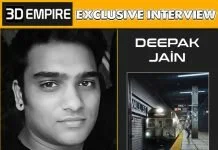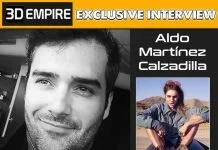3DE – First of all; we thank you for accepting this interview with us. Will you please shortly introduce yourself?
Thank you for the invitation. My name is Ander Alencar, I’m from Brazil and I have 39 years old. I am a entrepreneur, founder of Oficina 3D and also founder of the training program called RENDERMIND, which the main porpose is to transform the scenario of the realistic rendering market for architecture.
All these came out from my passion for architecture, photography, music and technology. But, in essence, I am a 3D artist, who seeks to bring realism and anticipate the future of real estate releases through creative softwares.
3DE – When and how did you begin to deal with 3d art?
My renderings were not always so realistic like the ones I post today, obviously.
In 1999 I worked in an office, I was unhappy and unmotivated, I didn’t like my job. Besides this, I was in college, but I had no money to continue. To make a long story short, I didn’t like what I was doing and I had no money to finish my college degree.
I believe that a lot of people passed throught this situation, or they are passing right now. But I was Lucky. It was at that time that something crazy happened that changed the course of my professional life: I saw a poster that had an image of the film Ice Age stuck on the wall of the architecture school. It was an advertising poster for a course, it was written that it was the first course in Brazil that was teaching the software used in the movie industry.
Then I had what I thought was the first big idea: “I need the right tool to achieve realistic rendering!”.
I believed that I could learn the techniques that were used in the film industry and apply them in a diferent field that was my passion – Architecture.
3DE – Did you improve your 3d knowledge by online tutorials-books or did you ever take an 3d course?
My first course in architectural design was about freehand techniques, like technical drawings and perspectives. That was in 1996, after that I never left the world of architecture and visualization. My biggest motivation was other artists and their work.
I started the undergraduate course in Architecture, but I did not finish, in that same period the opportunity came and than I went to to take a course in Águas de Lindóia – SP, a course that had never been taught, until then. Right there they taught how to use film animation techniques. After the course I realised that I could combine these techniques to use in architecture, and that’s what I did.
And since then, I dedicate myself to online courses and events in the field where artists from all over the world share their knowledge.
3DE – Which softwares do you use?
I used vray for 15 years as the main rendering engine, but today I use Corona Renderer, I just loved the intuitive and straightforward way to configure it, I consider it a super tool for those who want to render architecture.
But I am always searching for softwares and solutions that could add to the final result.
I am restless, and I always ask for my team to bring news and updates, new ways to do something, in a more efficient way, to bring always results that are even better than before. I believe that is what keeps everything moving. The whole team together to deliver the best they can throught the technology that we have available.
3DE – What kind of workflow do you follow during the creation of a scene of yours?
First of all, I save a folder of references Usually my references are from architectural photographs. And it is from them that I get inspiration to make 3D environments that are as realistic as they are.
3DE – What are your motivations while working on a new scene?
After having photographic references, I seek for inspiration in nature, light, shadow, texture and movements. I am perfectionist by nature, my desire is to work on a image for a few days, because every time we look at it there is something to be improved. But, my motivation is to make the person look at a 3D environment and feel himself in it.
3DE – Do you ever loose your motivation and passion of 3d sometimes? If you do, how do you deal with it and get back into your mood?
Yes, it happens to sometimes, not loose the passion, but motivation slow down, and when it happens I try to do other activities that I love to do, such as playing, listening to music, traveling and enjoying the family.
3DE – When we check your works; we see that you mostly deal with concept-themed scenes instead of average usual interior or exterior renders. Is there a special reason for this?
Yes, I have a studio that has been working with real state developers for more than 20 years with their real state releases. Today we have a team of 40 employees, and I still follow closely everything that we develop, however, I have more time to dedicate myself to conceptual scenes, and to my architecture rendering course – where I teach 3D artists to upgrade theis skills.
3DE – What kind of difficulties do you meet in your business sector regarding 3d art?
The architecture rendering market still has a long way to go, and the difficulties are less than they were years ago, when I started.
I can say that one of the difficulties is to find people with the right skills.
And today I can contribute to this evolution, I developed a training method called Rendermind. It is an overview of techniques and summarized experiences. We apply all of these methodology today at Oficina3D, and it works very well. It also made several artists evolve and grow their own businesses. My greatest wish is to improve and add value to this field. I believe we are on a good path.
3DE – Which one is more important to you; Making an artistic render or Making a render in least time possible to present to the client?
I always tell my collaborators and students that doing well and doing badly takes the same time. But, of course, there are different projects and clients, there are those whose pain is timing, and others that want and need something more artistic. But, the quality has to be the same, for both processes.
3DE – Which one is more important? The software or the talent of the artist who uses that software?
I would add dedication, because only with it the artist will polish their talent, and with that the software will be just the tool.
3DE – What are your advices to newbies?
Dedicate yourself to the maximum, seek inspiration, you have lots of good informations on the internet to study and improve. And never give up on your dreams. 😉
THANK YOU SO MUCH FOR THE INTERVIEW…







